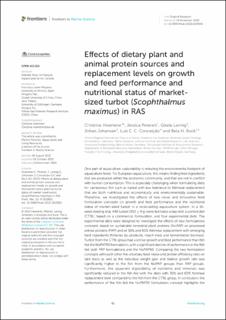| dc.contributor.author | Hoerterer, Christina | |
| dc.contributor.author | Petereit, Jessica | |
| dc.contributor.author | Lannig, Gisela | |
| dc.contributor.author | Johansen, Johan | |
| dc.contributor.author | Conceição, Luis E. C. | |
| dc.contributor.author | Buck, Bela H. | |
| dc.date.accessioned | 2022-12-27T14:35:44Z | |
| dc.date.available | 2022-12-27T14:35:44Z | |
| dc.date.created | 2022-12-14T13:27:43Z | |
| dc.date.issued | 2022-11-14 | |
| dc.identifier.citation | Frontiers in Marine Science. 2022, 9 1-16. | en_US |
| dc.identifier.issn | 2296-7745 | |
| dc.identifier.uri | https://hdl.handle.net/11250/3039584 | |
| dc.description.abstract | One part of aquaculture sustainability is reducing the environmental footprint of aquaculture feeds. For European aquaculture, this means finding feed ingredients that are produced within the economic community, and that are not in conflict with human consumption. This is especially challenging when formulating diets for carnivorous fish such as turbot with low tolerance to fishmeal replacement that are both nutritious and economically and environmentally sustainable. Therefore, we investigated the effects of two novel and innovative feed formulation concepts on growth and feed performance and the nutritional status of market-sized turbot in a recirculating aquaculture system. In a 16-week feeding trial, 440 turbot (300 ± 9 g) were fed twice a day with a control diet (CTRL), based on a commercial formulation, and four experimental diets. The experimental diets were designed to investigate the effects of two formulations concepts based on sustainable terrestrial plant proteins (NoPAP) or processed animal proteins (PAP) and of 30% and 60% fishmeal replacement with emerging feed ingredients (fisheries by-products, insect meal and fermentation biomass). Turbot from the CTRL group had a similar growth and feed performance than fish fed the NoPAP30 formulation, with a significant decline of performance in the fish fed both PAP formulations and the NoPAP60. Comparing the two formulation concepts with each other the voluntary feed intake and protein efficiency ratio on tank basis as well as the individual weight gain and relative growth rate was significantly higher in the fish from the NoPAP groups than PAP groups. Furthermore, the apparent digestibility of nutrients and minerals was significantly reduced in the fish fed with the diets with 30% and 60% fishmeal replacement level compared to the fish from the CTRL group. In conclusion, the performance of the fish fed the NoPAP30 formulation concept highlights the potential of the used combination of sustainable ingredients, such as fisheries by-products, insect meal, microbial biomass and plant protein for turbot. Furthermore, this study shows that turbot has a higher tolerance to the incorporation of plant and insect protein than of processed animal protein. | en_US |
| dc.language.iso | eng | en_US |
| dc.publisher | Frontiers Media | en_US |
| dc.rights | Navngivelse 4.0 Internasjonal | * |
| dc.rights.uri | http://creativecommons.org/licenses/by/4.0/deed.no | * |
| dc.title | Effects of dietary plant and animal protein sources and replacement levels on growth and feed performance and nutritional status of market-sized turbot (Scophthalmus maximus) in RAS | en_US |
| dc.title.alternative | Effects of dietary plant and animal protein sources and replacement levels on growth and feed performance and nutritional status of market-sized turbot (Scophthalmus maximus) in RAS | en_US |
| dc.type | Peer reviewed | en_US |
| dc.type | Journal article | en_US |
| dc.description.version | publishedVersion | en_US |
| dc.rights.holder | © 2022 Hoerterer, Petereit, Lannig, Johansen, Conceicão and Buck | en_US |
| dc.source.pagenumber | 1-16 | en_US |
| dc.source.volume | 9 | en_US |
| dc.source.journal | Frontiers in Marine Science | en_US |
| dc.identifier.doi | 10.3389/fmars.2022.1023001 | |
| dc.identifier.cristin | 2093130 | |
| dc.relation.project | EC/H2020/773330 | en_US |
| dc.source.articlenumber | 1023001 | en_US |
| cristin.ispublished | true | |
| cristin.fulltext | original | |
| cristin.qualitycode | 1 | |

